
Yellow-rumped Warbler by Jennifer Dobey
Migration begins in March and April for many shorebirds, songbirds, waterfowl and raptors. But keep an eye out for behavior changing in year-round species, too. Species that spent the winter together in flocks, such as Northern Flickers and Meadowlarks, become more solitary as they seek out breeding habitats. Woodpeckers drum on resonant surfaces — including vinyl house siding and metal drain pipes — making themselves known to rivals. Wild Turkeys fan their feathers for mates. Northern Bobwhites depart their winter coveys, form pairs, and might even lay their first clutch of eggs by April.
In the Omaha metro area, early arrivals, such as male Red-winged Blackbirds, sing out in marshes even while we feel like we haven’t quite shaken off winter. You might find a recently returned Killdeer leading around precocious chicks before most songbirds have even thought about building a nest! Migratory species to watch for in March and April include sparrows such as Lincoln’s Sparrow, Savannah Sparrow, and Vesper Sparrow. Listen especially for the unique warbling song of Fox Sparrows that have stopped in a thicket on their way north. In March, quirky American Woodcocks perform display flights and sound their “peent” calls in the evening. Look for flocks of Franklin’s Gulls with their signature pink bellies feeding on agricultural fields and roosting in and around lakes. In April, the arrival of Yellow-rumped Warblers is the prelude to the flood of warblers and vireos to come later in the spring. You might spot Caspian Terns and Forster’s Terns over water bodies beginning in April, too.
If you’re able to travel beyond Omaha, consider a trip to the Sandhill Crane migration stopover sites along the Platte River. You’ll be rewarded with the sights and sounds of thousands of cranes – and the company of many enthusiastic birders. Be prepared to dress warmly. Crane numbers typically reach their peak in the second half of March. Prime spots for crane watching include the Rowe Sanctuary east of Kearney and the Alda Sandhill Crane Viewing Deck southwest of Grand Island.
Rainy weather can make early spring birding difficult, but those storm systems can also hold up migratory birds in town for another day or two before they head north! So don’t be discouraged by April showers – when there’s a break in the rain, venture out and see which birds emerge from hiding.

